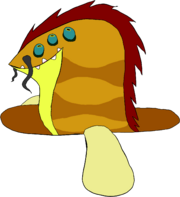Squirrely Gumbidru
| Squirrely Gumbidru | |
|---|---|
| Enemy | |
| Family | Bogbass |
The Squirrely Gumbidru is a species of larger bogbass that lives in mud and spits up spiked objects.
In fanon games
Below this point is where users place their version of the Squirrely Gumbidru.
In Pikmin: Interstellar Cryptid
|
This article or section presents information pertaining to Pikmin: Interstellar Cryptid, a fanon game created by CarrotStilts1. |
| |||
|---|---|---|---|

| |||
| Scientific name | Lutormientis vomitagnum | ||
| Family | Bogbass | ||
| Caves | Centifly Haven | ||
| Carry weight | N/A | ||
| Attacks | Replants, crushes, and eats Pikmin, spits spiny projectiles and enemies | ||
The Squirrely Gumbidru is a boss in Pikmin: Interstellar Cryptid. It resembles its smaller relative, the Nutty Gumbobi, but yellow with a much longer dorsal fin. It has black barbels, and peg-like teeth that protrude from its mouth at all times. The most striking feature of this massive fish is its six blue eyes, with three on each side of its head. Unlike its smaller relative, the Squirrely Gumbidru lives in mud, rather than solid ground. It appears as the boss of Centifly Haven. When first entering the final sublevel there will be nothing but a single Centipare hovering over a muddy crater in the center of the arena. When this crater is approached, however, the Squirrely Gumbidru will lunge out and eat the Centipare alive, chewing and swallowing it. The Centipare's soul will float away as the creature lets out a primal roar, and initiates the battle.
The main attack of the Squirrely Gumbidru is to spit up spiked pinecones, which will roll around the arena indefinitely due to its halfpipe-like shape. It may accidentally break a spiked pinecone by crushing it under its fin, but the objects can also break on their own. It may also spit a wave of mud at Pikmin, which buries them in the ground. It can also hack and cough up numerous, remarkably sized enemies, such as Mama Sheargrubs, Toady Bloysters, and Lesser Filthags. Their bodies will simply disappear when defeated. When at the last quarter of its health, it will crawl out of its pit and chase the squad on land, threatening to eat and crush them. During this phase, its tail must be attacked. Although it chases in a circle around its crater of mud, If twenty Ice Pikmin are used to freeze the mud, it will often forgo its standard patrol route and pursue across the whole arena. Since Ice Pikmin are only found near the end of the story, this strategy isn't always viable.
When defeated, the pained creature will slink back into its crater of mud. After this, its mouth will emerge to spit up a ship part, and then recede once more. If the mud is frozen as this happens, the Squirrely Gumbidru will break the ice and scatter the Ice Pikmin around the solid ground.
Notes
Olimar's notes
- “While behaviorally similar to its smaller relative, the squirrely gumbidru uses much larger spiked objects, the pinecones of certain conifers, instead of the smaller nuts the nutty gumbobi uses. This is because those particular morsels could easily slip through the squirrely gumbidru's massive esophagus and end up in its stomach, rather than the organ protective nuts are stored in. The nut, with its hard shell and spines, is not easily digested and can tear the stomach lining, so massive pinecones are used as a substitute. It's this one difference that allows the creatures filling an identical niche to coexist in the same ecosystem.”
Louie's notes
- “The meat smells rather repugnant, so use some rosemary whilst frying it to ensure all guests will try it with an open mind.”
Bentley's notes
- “I've never seen a catch this big in my whole life! It makes me want to become a fisherman so badly, but as a cryptozoologist, I'm already feeling quite fulfilled. I'm so glad this is in the PNF-404 creature database, because more people need to know of them!”
Eloise's notes
- “This creature looks... very unconventional. What are the extra eyes for? I have a theory that they're for assistance in seeing through the silt it sifts through, but we've just discovered it, so it's open to interpretation.”
